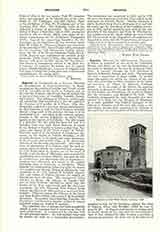

Segorbe (or CASTELLON DE LA PLANA), Diocese of (SEGOBIENSIS, or CASTELLIONENSIS), in Spain, bounded on the north by Castellon and Teruel, on the east by Castellon, on the south by Valencia, and on the west by Valencia and Teruel, has its jurisdiction in the civil Provinces of Castellon, Valencia, Teruel, and Cuenca. It is suffragan of Valencia, and its capital, containing 7500 inhabitants, is also the capital of the Province of Castellon de la Plana. This city, though the capital of a province, has no episcopal see: by the Concordat of 1851 the See of Tortosa, to which diocese a large part of the province belongs, is to be transferred to it. According to the common opinion, Segorbe is the ancient Segobriga, of which Pliny speaks as the capital of Celtiberia. For this reason it is probable that the town has been the seat of a bishopric from very early times; however, no name of any Bishop of Segorbe is known earlier than Proculus, who signed in the Third Council of Toledo. Porcarius assisted at the Council of Gundemar; Antonius, at the fourth of Toledo; Floridius, at the seventh; Eusicius, at the ninth and tenth; Memorius, at the eleventh and twelfth; Olipa, at the thirteenth; Anterius at the fifteenth and sixteenth. After this we have no information of its bishops until the Arab invasion, when its church was converted into a mosque. In 1172 Pedro Ruiz de Azagra, son of the Lord of Estella, took the city of Albarracin, and succeeded in establishing there a bishop (Martin), who took the title of Arcabricense, and afterwards that of Segobricense, thinking that Albarracin was nearer to the ancient Segobriga than to Ercavica, or Arcabrica. When Segorbe was conquered by Jaime I in 1245, its church was purified, and Jimeno, Bishop of Albarracin, took possession of it. The bishops of Valencia opposed this, and Arnau of Peralta entered the church of Segorbe by force of arms. The controversy being referred to Rome, the bishops of Segorbe had part of their territory restored to them; but the Schism of the West supervened, and the status quo continued. In 1571 Francisco Soto Salazar being bishop, the Diocese of Albarracin was separated from Segorbe. Eminent among the bishops of the latter was Juan Bautista Perez, who exposed the fraudulent chronicles. In modern times Domingo Canubio, the Dominican, and Francisco Aguilar, author of various historical works are worthy of mention.
The cathedral, once a mosque, has been completely rebuilt in such a manner that it preserves no trace of Arab architecture. It is connected by a bridge with the old episcopal palace. Its time-stained tower and its cloister are built on a trapezoidal ground-plan. The restoration was completed in 1534; and in 1795 the nave was lengthened, and new altars added, in the episcopate of Lorenzo Haedo. Segorbe possessed a castle, in which King Martin of Aragon lived and held his court; but the demolition of this building was begun in 1785, and its materials were used for the construction of the hospital and Casa de Misericordia. The seminary is in the Jesuit college given by Carlos III. The convents of the Dominicans, Franciscans, the Augustinian nuns, and the Charterhouse (Cartuja) of Valdecristo have been converted to secular uses.
RAMON RUIZ AMADO

